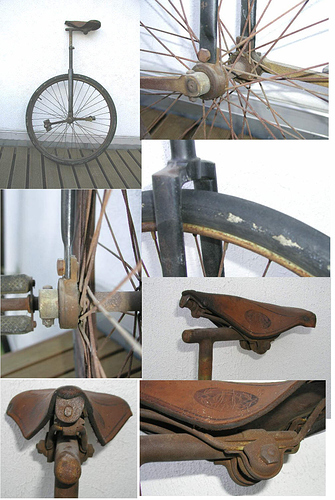Hmmm. I have a 1959 uni which shares many of those features.
I notice steel cottered cranks These were still popular in cheap bicycles until the late 1970s/early 1980s.
I notice traditional rubber block pedals with chrome domes at the ends. I think these were popular from before the second world war until the 1970s, and they’re still available from a certain type of bike shop.
It looks like the rim doesn;t have a braking surface suitable for calliper brakes. If so, does it have a biconcaver rim shaped to work with stirrup brakes? These died out in the 1960s (approx.).
The seat is a fairly traditional design, and similar ones are still available.
The spokes look similar to modern ones. The wheel is imperial sized. The frame looks well made, except that the way that the bearings are attached looks weird.
Now, what sort of person would have ridden a unicycle in the ‘olden days’? Assuming it wasn’t made for a stage or circus performer, then it was made as a leisure item. It would have been a massive investment for a working man before WW2; I doubt that the upper classes would have got involved in unicycling before WW2, as they were still into obvious status (big cars etc.) and snobbery rather than ‘inverted snobbery’. So prewar looks unlikely.
After WW2, people’s social and financial horizons were rather different. Lots of young men had been out and about in the world, seen things, learned things, and got some new ideas. I know my 1959 one was owned by a soldier, and that there was quite a fashion for unicycling on some army bases around that time (as recounted to me by the chap who sold it to me).
My GUESS is that it’s post war, and allowing for a bit of time for people to adjust, and for materials to become available, probably 1950s. This could be completely wrong, but it makes sense. There is nothing obvious (from the pictures) to make it earlier, and the components look generally pre-1960s.
Interesting device.
